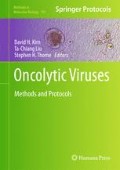Abstract
Oncolytic viruses, such as reovirus, offer a promising approach to cancer treatment. Concurrently, oncolytic viruses provide a valuable tool for deciphering unique attributes of cancer cells that support superior virus replication, cell death, or virus dissemination. Through our studies on various cancer cell lines, as well as isogenic cells with and without transformation by oncogenic Ras, we have identified at least four steps of virus replication that can be augmented in transformed cells. Ras transformation can support efficient reovirus uncoating during entry, production of progeny with high infectious capacity, and reovirus-induced apoptosis. Furthermore, Ras transformation also precludes interferon production following reovirus infection, permitting enhanced cell-to-cell virus spread. Methods that measure the efficiency of reovirus replication and dissemination described in this chapter can be used in combination with assorted cell culture systems to better understand the host factors that regulate reovirus oncolysis.
Access this chapter
Tax calculation will be finalised at checkout
Purchases are for personal use only
References
Coffey M.C., Strong J.E., Forsyth P.A., Lee P.W. (1998) Reovirus therapy of tumors with activated Ras pathway. Science282: 1332–4.
Hirasawa K., Nishikawa S.G., Norman K.L., Alain T., Kossakowska A., Lee P.W. (2002) Oncolytic reovirus against ovarian and colon cancer. Cancer Res62: 1696–701.
Norman K.L., Coffey M.C., Hirasawa K. et al. (2002) Reovirus oncolysis of human breast cancer. Hum Gene Ther13: 641–52.
Strong J.E., Coffey M.C., Tang D., Sabinin P., Lee P.W. (1998) The molecular basis of viral oncolysis: usurpation of the Ras signaling pathway by reovirus. EMBO J17: 3351–62.
Marcato P., Shmulevitz M., Pan D., Stoltz D., Lee P.W. (2007) Ras transformation mediates reovirus oncolysis by enhancing virus uncoating, particle infectivity, and apoptosis-dependent release. Mol Ther15: 1522–30.
Borden E.C., Sen G.C., Uze G. et al. (2007) Interferons at age 50: past, current and future impact on biomedicine. Nat Rev Drug Discov6: 975–90.
Shmulevitz M., Pan L.Z., Garant K., Pan D., Lee P.W. (2010) Oncogenic Ras promotes reovirus spread by suppressing IFN-beta production through negative regulation of RIG-I signaling. CancerRes 70: 4912–21.
Mendez I.I., Hermann L.L., Hazelton P.R., Coombs K.M. (2000) A comparative analysis of freon substitutes in the purification of reovirus and calicivirus. J Virol Methods90: 59–67.
Virgin H.W., Mann M.A., Fields B.N., Tyler K.L. (1991) Monoclonal antibodies to reovirus reveal structure/function relationships between capsid proteins and genetics of susceptibility to antibody action. J Virol65: 6772–81.
Duncia J.V., Santella J.B., III, Higley C.A. et al. (1998) MEK inhibitors: the chemistry and biological activity of U0126, its analogs, and cyclization products. Bioorg Med Chem Lett8: 2839–44.
Tyler K.L., Mann M.A., Fields B.N., Virgin H.W. (1993) Protective anti-reovirus monoclonal antibodies and their effects on viral pathogenesis. J Virol67: 3446–53.
Virgin H.W., Bassel-Duby R., Fields B.N., Tyler K.L. (1988) Antibody protects against lethal infection with the neurally spreading reovirus type 3 (Dearing). J Virol62: 4594–604.
Author information
Authors and Affiliations
Corresponding author
Editor information
Editors and Affiliations
Rights and permissions
Copyright information
© 2012 Springer Science+Business Media, LLC
About this protocol
Cite this protocol
Shmulevitz, M., Lee, P.W.K. (2012). Exploring Host Factors that Impact Reovirus Replication, Dissemination, and Reovirus-Induced Cell Death in Cancer Versus Normal Cells in Culture. In: Kirn, D., Liu, TC., Thorne, S. (eds) Oncolytic Viruses. Methods in Molecular Biology, vol 797. Humana, Totowa, NJ. https://doi.org/10.1007/978-1-61779-340-0_12
Download citation
DOI: https://doi.org/10.1007/978-1-61779-340-0_12
Published:
Publisher Name: Humana, Totowa, NJ
Print ISBN: 978-1-61779-339-4
Online ISBN: 978-1-61779-340-0
eBook Packages: Springer Protocols

